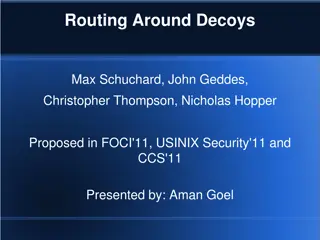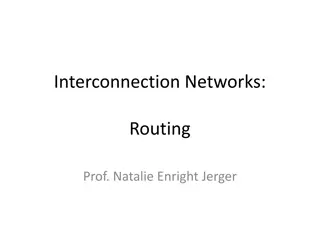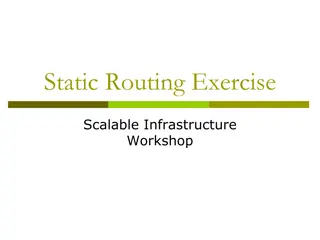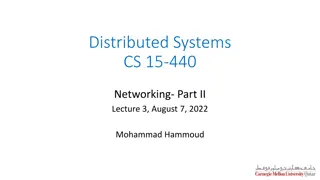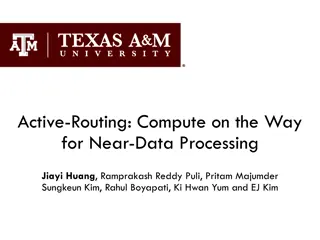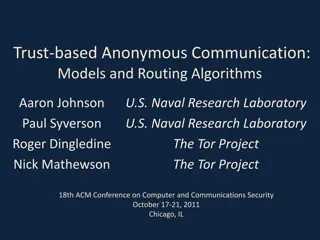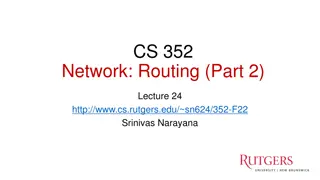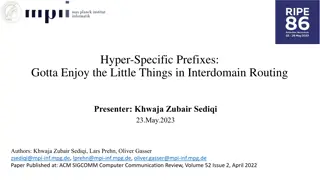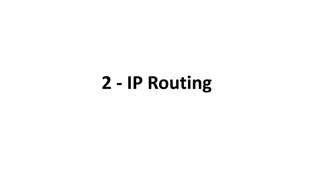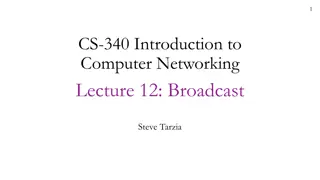Understanding IP Addressing and Routing in Computer Networks
IP (Internet Protocol) operates at Layer 3 of the OSI model and TCP/IP stack, facilitating the routing of data packets over computer networks. It is a connectionless protocol that uses hierarchical addressing to efficiently route packets to their destinations. IP addressing, such as the 32-bit IPv4 addresses, plays a crucial role in packet forwarding and network operation, ensuring that data reaches its intended recipients. This analogy of IP to mail delivery via a postal service helps illustrate its functioning in the digital world.
Download Presentation

Please find below an Image/Link to download the presentation.
The content on the website is provided AS IS for your information and personal use only. It may not be sold, licensed, or shared on other websites without obtaining consent from the author. Download presentation by click this link. If you encounter any issues during the download, it is possible that the publisher has removed the file from their server.
E N D
Presentation Transcript
COMPUTER NETWORK AND DESIGN CSCI 3385K
Understanding the TCP/IP Internet Layer Internet Protocol The IP component of TCP/IP determines where packets of data are to be routed based on their destination address. IP uses packets to carry information through the network. A packet is a self-contained, independent entity that contains data and sufficient information to be routed from the source to the destination without reliance on earlier exchanges.
IP Characteristics IP operates at Layer 3 (Network) of the OSI model and Layer 3 of the TCP/IP (Internet) stack. IP is a connectionless protocol in which one-way datagram is sent to the destination without advance notification to the destination device. The destination device receive the data and does not return any status information to the sending device. IP uses hierarchical addressing in which the network ID is like a street and the host ID is like a house or office building on that street. IP provides services on a best-effort basis and does not guarantee packet delivery. A packet can be misdirected, duplicated or lost on the way to its destination. IP does not provide any special features that recover corrupted packets. These services are instead provided by the end systems of the network. In real-time voice or video transfers, a few lost packets are tolerable; speed is more important than packet recovery, because recovering packets would delay the real-time process.
IP Example: Delivery a letter through a Postal Service An analogy of IP service would be mail delivery by postal service. In this example, you live in San Francisco and your mother lives in New York. You write three separate letters to your mother. You seal each letter in a separate envelope, address each letter to your mother, and write return address in the upper left-hand corner of each envelope. You deposit the three letters in the outgoing mail slot at your local post office. The postal service will make the best attempt to deliver the three letters to your mother in New York. However, the postal service will not guarantee that the letters will arrive at their destination. The postal service will not guarantee that all three letter will be handle by the same carriers or the same route. Finally, the postal service will not guarantee that the letters will arrive in the order in which you mailed them.
IP Addressing Facilitates the routing of packets over the network. Uses logical addresses known as IP address (32-bit IPv4). Every host, computer, networking device, or peripheral connected to the internet has a unique 32-bit IP address that identifies it. Without structure for allocating all those IP addresses, it would be impossible to route packets efficiently. Learning IP address structure and how they function in the operation of the network provides an understanding of how IP packet are forwarded over the networks using TCP/IP
IP Addressing cont. IPv4 address is the most common type of address currently used on the Internet. IPv4 are 32-bit numbers that describe the location of a network device. IP address is a hierarchical address and consist of two parts: Network address portion (network ID): describes the network of which this IP address is a part of. The router maintains information about routes to each network. Host address component (host ID): identifies a specific endpoint. These endpoints are the servers, computers, and other devices connected to the network. It is assigned by organizations to individual devices.
IP Addressing Fields As data travels down the protocol stack it is encapsulated. At the Internet Layer it is encapsulated into a PDU (commonly called a packet or datagram) The header for this packet has several fields, we will focus on two of those fields. Source Address: Specifies the sending node s IP address Destination Address: Specifies the receiving node s address
IP Address Format: Dotted Decimal Notation In any given IP address, some portion of the 32-bit number represents the network and the remaining bits represent the host. Many hosts may share the same network address, combining the network address with a host address uniquely identifies any device connected to the network. 32-bit numbers are broken up into 4 groups of numbers called octets (1 octet=8 bits) Each octet is represented as a decimal number between 0 and 255 and separated by a period. This scheme is known as dotted decimal notation ex: 172.16.128.17 spoken as 172 dot 16 dot 128 dot 17
IP Address Format: Number Conversion Decimal base 10 (0 through 9) example: 5753 5(thousands) 7(hundreds) 5(tens) 3(ones) 103 Binary base 2 (0 and 1) example: 102 101100 27 1 26 0 25 1 2423222120 0 0 0 0 0 128 64 32 16 8 4 2 1 128 + 32 = 160
IP Address Format: Number Conversion Binary base 2 (0 and 1) example: 27 1 26 1 25 1 2423222120 1 1 1 1 1 128 64 32 16 8 4 2 1 128 + 64 + 32 + 16 + 8 + 4 + 2 + 1 = 255
IP Address Format: Number Conversion Example: 168.20.197.137 27 1 26 0 25 1 2423222120 0 1 0 0 0 128 64 32 16 8 4 2 1 1010100.00010100.11000101.10001001 128 + 0 + 32 + 0 + 8 + 0 + 0 + 0 = 168 (10101000) 0 + 0 + 0 + 16 + 0 + 4 + 0 + 0 = 20 (00010100) 128 + 64 + 0 + 0 + 0 + 4 + 0 + 1 = 197 (11000101) 128 + 0 + 0 + 0 + 8 + 0 + 0 + 1 = 137 (10001001)
IP Address Format: Number Conversion Example: 192.168.1.100 27 26 0 0 25 0 2423222120 0 0 0 0 0 128 64 32 16 8 4 2 1 11000000.10101000.00000001.01100100 128 + 1 + 0 + 0 + 0 + 0 + 0 + 0 = 192 (11000000) 128 + 0 + 1 + 0 + 1 + 0 + 0 + 0 = 168 (10101000) 0 + 0 + 0 + 0 + 0 + 0 + 0 + 1 = 1 (00000001) 0 + 1 + 1 + 0 + 0 + 1 + 0 + 0 = 100 (01100100)
IP Address Classes To accommodate different sizes of network and aid in classifying them IP addresses are divided into categories called classes. Assigning IP addresses to classes is known as classful addressing The classes were determined during the early days of the Internet by the Internet Assigned Numbers Authority (IANA) Each IP address is broken down into a network ID and the host ID. In addition, a bit or bit sequence at the start of each address determines the class of the address.
Class A Class A address uses only the first octet (8 bits) of the 32-bit number to indicate the network address. Remainder three octets of the 32-bit number are used for host addresses. First bit of a Class A address is always 0 and since the first bit is a 0 the lowest number that can represent is 00000000 (decimal 0) and the highest number can be represented is 01111111 (decimal 127). However, these two network numbers 0 and 127 are reserved and cannot be used as network addresses. Any address that starts with the value of 1 and 126 in the first octet represent a Class A address.
Class B Class B address uses two octets (16 bits) of the 32-bit number to indicate the network address. Remainder two octets of the 32-bit number are used for host addresses. First 2 bits of a Class B address are always binary10. Starting the first octet with binary 10 ensures that the Class B space is separated from the upper levels of the Class A space. Remaining 6 bits in the first octet may populated with either 1s or 0s. Lowest number that can be represented with Class B address is 10000000 (decimal 128) and the highest number that can be represented is 10111111 (decimal 191) Any address that starts with a value in the range of 128-191 in the first octet is a Class B
Class C Class C address uses three octets (24 bits) of the 32-bit number to indicate the network address. Remainder one octet of the 32-bit number is used for host addresses. Class C address always begins with binary110. Lowest number that can be represented with Class C address is 11000000 (decimal 192) and the highest number that can be represented is 11011111 (decimal 223) Any address that starts with a value in the range of 192-223 in the first octet is a Class C
Reserved IP Addresses Network Address An IP address that has binary 0s in all host bit positions is reserved for the network address: Example for Class A, B, and C: 10.0.0.0 is the IP address of the network containing the host 10.1.2.3 172.16.0.0 is the IP address of the network containing the host 172.16.16.1 (host portion) 192.16.1.0 is the IP address of the network containing the host 192.16.1.2 (host portion) A router uses a network IP address when it searches its IP route table for the destination network location
Reserved IP Addresses Direct Broadcast Address To send data to all the devices on a network, a broadcast address is used. Broadcast IP address end with a binary 1s in the entire host portion (host field) Example: For network 172.16.0.0 in which last 16 bits represent the host field the broadcast that would sent out to all devices on that network would include a destination address of 172.16.255.255
Reserved IP Addresses Local Broadcast Address If an IP device wants to communicate with all devices on the local network, it sets the destination address to all 1s (255.255.255.255) and transmit the packet. Example: Hosts that do not know their network number and are asking some server for it may use this address. Local Loopback Address A local loopback address is used to let the system send a message to itself for testing. A typical loopback IP address is 127.0.0.1
Public IP Addresses Internet stability depends directly on the uniqueness of publicly network addresses A mechanism is needed to ensure that addresses are in fact unique. Originally this responsibility rested to InterNIC (Inter Network Information Center) Eventually this responsibility was transferred to the IANA IANA carefully manages the remaining supply of IP address to ensure that duplication of publicly used addresses does not occur. Duplication would cause instability in the Internet and compromise its capability to deliver datagrams to networks using the duplicate addresses.
Public IP Addresses To obtain an IP address or block of addresses, you will need to contact an ISP (Internet Service Provider). Then the ISP will contact their upstream registry or regional registry at one of the organizations: APNIC (Asia Pacific Network Information Center) ARIN (American Registry for Internet Numbers) RIPE NCC (Reeaux IP Euripeens Network Coordination Centre) With the rapid grow of the Internet, public IP addresses began to run out, so new addressing schemes such as Network Address Translation (NAT), classless interdomain routing (CIDR) and IPv6 were developed to help solve the problem.
Private IP Addresses While Internet require a globally unique IP address, private hosts that are not connected to the Internet can use any valid address, as long as it is unique in the private network. Many private networks exist alongside public networks and grabbing any other address is strongly discouraged. Three blocks of IP addresses (one Class A network, 16 Class B networks, and 256 Class C networks) have been designated for private, internal use. Addresses in this range are not routed on the Internet backbone. Internet routers are configured to discard private addresses When addressing a nonpublic intranet, private addresses can be used instead of globally unique addresses. When a network using private addresses must connect to the Internet, it is necessary to translate the private addresses to public addresses. This translation process is NAT and a router is often the network device that performs NAT (Network Address Translation)
Dynamic Host Configuration Protocol (DHCP) DHCP is used to assign IP addresses automatically and to set TCP/IP stack configuration parameters, such as the subnet mask, default router, and Domain Name System (DNS) servers. DHCP is also used to provided other configuration information as necessary, including the length of time the address has been allocated to the host. DCHP consists of two components: A protocol for delivering host-specific configuration parameters from DHCP server to a host A mechanism for allocating network addresses to hosts.
Dynamic Host Configuration Protocol Cont. Using DHCP, a host can obtain an IP address quickly and dynamically. It requires a defined range of IP address on a DHCP server As hosts come online, they contact the DHCP server and request address information. The DHCP server selects an address and allocates it to that host. The address is only leased to the host, so that host will periodically contact the DHCP server to extend the lease. The lease mechanism ensures that hosts that have been moved or are switched off for extended periods of time do not hold to an address that they do not use. Addresses are return to the address pool by the DHCP server to be reallocated as necessary.
Domain Name System (DNS) DNS application provides an efficient way to convert human- readable names of IP end systems into machine-readable IP addresses necessary for routing. DNS mechanism is to convert symbolic name into IP address. DNS application frees users of IP networks from the burden of having to remember IP address. Without this freedom, the Internet would not be as popular or as usable as it has become.
Using Common Host Tools Most operating systems provide a series of tools that can be used to verify the host addressing.
Using Common Host Tools Cont. IPCONFIG used to display all current TCP/IP network configuration values and refresh DHCP and DNS setting. Use without parameters, ipconfig displays the IP address, subnet mask and default gateway for all adapter
Using Common Host Tools Cont. Syntax: Ipconfig [/all] [/renew [Adapter]] [/release [Adapter]] [/flushdns] [/displaydns] [/registerdns] [/showclassid Adapter] [/setclassid Adapter [ClassID]] /all: displays the full TCP/IP configuration for all adapters /renew [Adapter]: renews DHCP configuration for all adapters /release [Adapter]: sends a DHCPRELEASE message to the DHCP server to release the current DHCP configuration and discard the IP address for either all adapter or a specific adapter /flushdns: flushes and resets the content of the DNS client resolver cache. Good for DNS troubleshooting. /displaydns: displays the content of the DNS client resolver cache, which includes entries, preloaded from the local Host file and any recently obtained resource records for name queries resolved by the computer /registerdns: initiates manual dynamic registration for the DNS names and IP addresses that are configured at a computer. Good to use when a DNS name registration failed.





